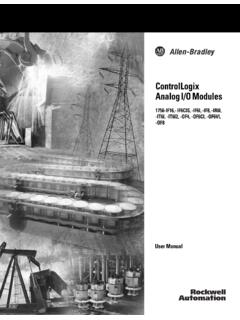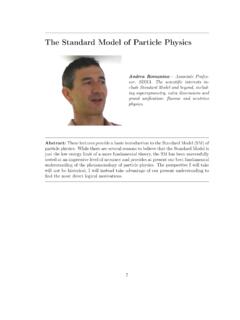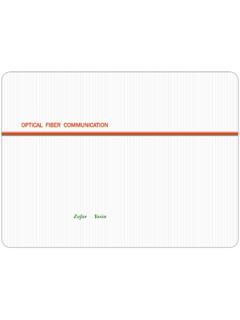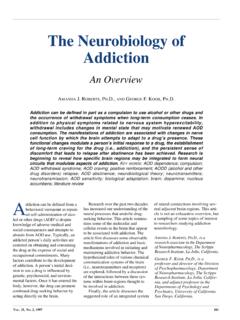Transcription of Early History of X Rays - SLAC National Accelerator Laboratory
1 Early History of X Raysby ALEXIASSMUS10 SUMMER 1995 The discovery of X raysin 1895 was thebeginning of arevolutionary change in our understanding of the physical THE WINTERof the year of his fiftieth birthday, and the year following his appointment to the leadership of the Universityof W rzburg, Rector Wilhelm Conrad Roentgen noticed a bariumplatinocyanide screen fluorescing in his Laboratory as hegenerated cathode rays in a Crookes tube some distance aside for a time his duties to the university and to hisstudents, Rector Roentgen spent the next six weeks in his labora-tory, working alone, and sharing nothing with his colleagues. BEAM LINE11 Three days before Christmas hebrought his wife into his laborato-ry, and they emerged with a photo-graph of the bones in her hand and ofthe ring on her finger. The W rzburgPhysico-Medical Society was the firstto hear of the new rays that couldpenetrate the body and photographits bones.
2 Roentgen delivered thenews on the 28th of December Warburg relayed it to the BerlinPhysical Society on the 4th of Janu-ary. The next day the Wiener Presscarried the news, and the day fol-lowing word of Roentgen s discoverybegan to spread by telegraph aroundthe the 13th of January, Roentgenpresented himself to the Kaiser andwas awarded the Prussian Order ofthe Crown, Second Class. And on the16th of January the The New-YorkTimesannounced the discovery asa new form of photography, whichrevealed hidden solids, penetratedwood, paper, and flesh, and exposedthe bones of the human frame. Menof science in this city are awaitingwith the utmost impatience thearrival of English technical journalswhich will give them the full par-ticulars of Professor Roentgen s dis-covery of a method of photographingopaque bodies, The New-YorkTimesbegan, and it concluded by pre-dicting the transformation of mod-ern surgery by enabling the surgeonto detect the presence of foreignbodies.
3 (Jan. 16, 1896, p. 9)The public was enthralled by thisnew form of photography and curi-ous to know the nature of the newrays. Physicians put it to immediateuse. Physicists sat up and took no-tice. The discovery of X rays was thefirst in a series of three discoveriesthat jolted the fin-de-si cledisci-pline out of itsmood of finality,of closing downthe books withever more precisemeasurements, oflosing itself in de-bates over statisticalmechanics, or of try-ing to ground allphysical phenomena inmathematically precisefluctuations of the three discoveries, X rays ,uranium rays , and the elec-tron, followed from one of themajor experimental traditions in thesecond half of the nineteenthcentury, the study of the dischargeof electricity in gases. All threecontributed to a profound transfor-mation of physics. In the 20th cen-tury, the discipline has been ground-ed in the study of with the invention of in-candescent lightbulbs, the studyof electrical dis-charge throughgases was madepossible by thedevelopment ofimproved vacu-um technologyin the 1850s.
4 Ear-ly on, Englishscientists wereinvestigating thepatterns of lightand dark that ap-peared in sealedlead-glass patterns inWilhelm Conrad Roentgen (1845 1923).(Courtesy of AIPE milio Segr VisualArchives)Forms of tube used by Roentgen in 1895 1896 for the production of X Museum, Munich12 SUMMER 1995transparent to ultra-violet Heinrich Hertz found that hecould pass the rays through metalfoil, a fellow German scientist, PhilipLenard, began to study them morecarefully. Lenard designed a tubewith a thin aluminum windowthrough which the rays couldemerge, and he measured how farthey could travel and still inducefluorescence. Defined in this way,the range of the cathode rays was sixto eight centimeters. Lenard s ex-periments inspired Roentgen to won-der if the rays in an attenuated formreally traveled farther, and heplanned experiments to see if asensitive electroscope would mea-sure a discharge at four times thedistance Lenard had line of work was outsideRoentgen s usual research pursuits,which had by this time gained himgreat stature in German science.
5 Sonof a cloth manufacturer and mer-chant from the Rhine province,Roentgen was not a particularlydiligent student in his youth. Heeventually made his way to thePolytechnic in Zurich, where heobtained a diploma in mechanicalengineering in 1868 and a doctor-ate one year later. In Zurich hebecame an assistant to August Kundtand moved along with him to theUniversity of W rzburg, and then onto the Physical Institute at Stras-bourg. His first move on his own wasto the chair of physics at Giessenin Hesse in 1879, from which hereceived many offers to go path upward in the Germanuniversity system was to follow callsto universities of higher and higherstature, and finally to obtain aninstitute of one s own. Roentgenthese partially evacuated tubes werestimulated by a voltage drop betweena cathode and an anode: typicallythere was a dark space, calledCrookes dark space; then a glow,called negative light; then anotherdark space, this one called Faraday s;and a final glow of positive light.
6 Ifthe air in the tube was exhausted un-til the first dark space expanded tofill the entire tube and all glows dis-appeared, then the rays emitted fromthe cathode could be rays cast shadows, and weredeflected by magnetic fields, butappeared to be immune to the ef-fects of static electric was to be characteristic of thenew ray physics to come the phys-ics of cathode rays , X rays , alpha rays ,beta rays , gamma rays , and N rays the nature of the cathode rays was indispute, the British favoring a streamof particles, those on the Continentpreferring to think of them as somesort of disturbance of the ether. (TheBritish position, and the research pro-gram developed by Thomson atthe Cavendish Laboratory to studyionization in gases, would result inthe discovery of the electron. But ourstory does not take us that way).A strong reason for believing thatthe cathode rays were particles wasthe observation that they wouldnot pass through matter that wasSir Joseph John Thomson, 1856 1940.
7 (Courtesy of the AIPN iels Bohr Library)Roentgen s apparatus for studying theionization of air by X rays , Museum, MunichBEAM LINE13refused the calls until the Universi-ty of W rzburg offered him theDirectorship of their Physical Insti-tute. In 1894 he was elected Rectorat W rzburg. In his inaugural ad-dress, given the year before his dis-covery of X rays , Roentgen statedthat the university is a nursery ofscientific research and mental edu-cation and cautioned that pride inone s profession is demanded, but notprofessional conceit, snobbery, oracademic arrogance, all of whichgrow from false egoism. *Roentgen s pride could rest in theover forty papers he had publishedfrom Strasbourg, Giessen, andW rzburg. These Early interestsranged widely crystals, pyroelec-trical and piezoelectrical phenomena,and the effects of pressure on liquidsand solids but did not yet includeelectrical discharges in gases.
8 He hadtaken his turn at measuring thespecific heat ratios of gases using asensitive thermometer of his ownmaking. He was an exact experi- menter who often made his ownapparatus a skill learned during histraining as an engineer in Zurich and he was able to measure ex-tremely small effects, surpassingeven Faraday s measurement of therotation of polarized light in turned to a new interestin October of 1895: the study of cath-ode rays . In the course of repeatingthe experiments of Hertz and Lenard,he happened to notice a glowing flu-orescent screen set off quite somedistance from the Crookes tube hewas operating. The screen sat muchfarther away than the six to eightcentimeters that Lenard had foundto be the maximum distance forwhich cathode rays maintain theirpower to induce fluorescence. Roent-gen recognized the effect as wor-thy of his undivided attention anddevoted the next six weeks to itsuninterrupted have speculated aboutwhy Roentgen was the first to rec-ognize the significance of this equipment, a cathode ray tubeand a fluorescing screen, had been inuse for decades.
9 In 1894 Thomsonhad seen fluorescence in German-glass tubing several feet from thedischarge tube. Others had notedfogged photographic plates. Butbefore Lenard s work, the object ofstudy was always the effects insidethe tube itself, and stray ultra-ultra-violet light could be used to explainthe fogging of photographic s great interest was in prov-ing, in contradiction to the British,the ethereal nature of cathode rays ,and he was the first to study theDemonstration by Crookes that cathoderays travel in straight lines: a) cathode;b) aluminum cross and anode; d) darkshadow; c) fluorescent Lenard, 1862 1947. (Courtesy ofUllstein Bilderdienst and the AIPN ielsBohr Library)*Quoted in Wilhelm Conrad Roentgen, Dictionary of Scientific Biography(New York: Scribner s, 1975), p. 1995effects of the rays in air or in a sec-ond glass tube into which he , a meticulous and ob-servant experimenter, made theobvious tests on the new X rays :Were they propagated in straightlines?
10 Were they refracted? Were theyreflected? Were they distinct fromcathode rays ? What were they? Likethe cathode rays , they moved instraight lines. Roentgen was unableto refract them with water and car-bon bisulphide in mica prisms. Norcould he concentrate the rays withebonite or glass lenses. With eboniteand aluminum prisms he noted thepossibility of refracted rays on a pho-tographic plate but could not observethis effect on a fluorescent further, he found that X rayscould pass freely through thick lay-ers of finely powdered rock salt,electrolytic salt powder, and zincdust, unlike visible light which,because of refraction and reflection,is hardly passed at all. He concludedthat X rays were not susceptible toregular refraction or found that the X raysoriginate from the bright fluores-cence on the tube where the cathoderays strike the glass and spread point of origin of the X raysmoves as the cathode rays are movedby a magnetic field, but the X raysthemselves are insensitive to themagnet.












